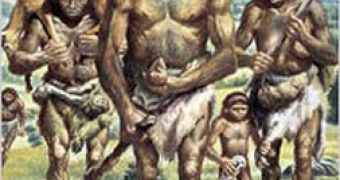Does your woman earn more than you do? In your house she is the one who wears the pants? Well? this may be a de-evolution. Because a versatile division of labor between men and women in Homo sapiens may explain the demise of the Neanderthals (image bellow), according to a theory proposed by two anthropologists at the University of Arizona.
Unlike modern humans, Neanderthal populations seem to have been engaged in a single main occupation, the hunting of large game, found Steven L. Kuhn and Mary C. Stiner. The division of economic labor by sex and age emerged relatively recently in human evolution and facilitated the spread of modern humans throughout Eurasia. This way, modern humans exploited the environment more efficiently, men hunting large game and women gathering small game and plant foods, this way outgrowing the Neanderthal populations.
Upper Paleolithic (45,000 - 10,000 years ago) sites occupied by modern humans provide a good evidence of different occupations, from small animal and bird remains, as well as the bone awls and needles used to make clothes.
"The competitive advantage enjoyed by modern humans came not just from new weapons and devices but from the ways in which their economic lives were organized around the advantages of cooperation and complementary subsistence roles for men, women, and children," said Kuhn.
These activities must have been divided between men and women, as is the case with modern foraging peoples. Instead, Neanderthals depended on large game, a high-stakes resource, like bison and wild horses, to fuel their massive body mass and high caloric intake. This way, they resisted for about 100,000 years, despite a punishing way of life, till the arrival from Africa of the modern humans.
The archaeological Neanderthal sites provide little direct evidence for a reliance on subsistence foods, such as milling stones to grind nuts and seeds. Neanderthal sites also include no bone needles, commonly used to make weather-resistant clothing or artificial shelters, and no small animal remains.
So what did Neanderthal women do to keep them occupied? Their skeletons are so robustly built that it is likely they did the same as the men, with the whole population engaged in bringing down large game, probably as game drivers and cutters of escape route.
Neanderthals did not use bows and arrows, but stone-tipped spears. Hunting large game at close range is dangerous, and Neanderthal skeletons bear copious fractures. The meat of large game provides a rich payoff, but even the best hunters have unlucky days.
The modern humans of the Upper Paleolithic, with their labor division and diversified food sources, would have been better prepared to secure a continuous food supply, this way protecting their reproductive core - women and children. "Earlier hominins pursued more narrowly focused economies, with women's activities more closely aligned with those of men with respect to schedule and ranging patterns," explained the researchers.
"It is impossible to argue that [Neanderthal] females and juveniles were fulfilling the same roles-or even an equally diverse suite of economic roles - as females and juveniles in recent hunter-gatherer groups," they add.
Thus, the emergence of "female" jobs, subsistence and skill-intensive craft, allowed H. sapiens in ecologically diverse tropical and sub-tropical regions to take advantage of more diverse environmental resources and possess higher population densities, providing the demographic push for modern humans to expand out of Africa.
It is interesting to see that the evolution of modern society is away from such diversity of roles between men and women, and toward one of more and more equal "male" and "female" roles.
Is this a de-evolution of Homo sapiens?

 14 DAY TRIAL //
14 DAY TRIAL // 
